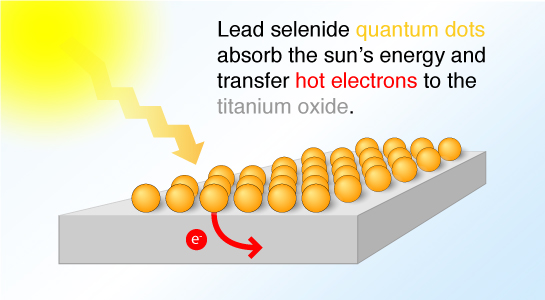Conventional solar cell efficiency could be increased from the current limit of 30 percent to more than 60 percent, suggests new research on quantum dots led by chemist Xiaoyang Zhu.
 AUSTIN, Texas—Conventional solar cell efficiency could be increased from the current limit of 30 percent to more than 60 percent, suggests new research on semiconductor nanocrystals, or quantum dots, led by chemist Xiaoyang Zhu at The University of Texas at Austin.
AUSTIN, Texas—Conventional solar cell efficiency could be increased from the current limit of 30 percent to more than 60 percent, suggests new research on semiconductor nanocrystals, or quantum dots, led by chemist Xiaoyang Zhu at The University of Texas at Austin.
Zhu and his colleagues report their results in this week’s Science.
The scientists have discovered a method to capture the higher energy sunlight that is lost as heat in conventional solar cells.
The maximum efficiency of the silicon solar cell in use today is about 31 percent. That’s because much of the energy from sunlight hitting a solar cell is too high to be turned into usable electricity. That energy, in the form of so-called “hot electrons,” is lost as heat.
If the higher energy sunlight, or more specifically the hot electrons, could be captured, solar-to-electric power conversion efficiency could be increased theoretically to as high as 66 percent.
“There are a few steps needed to create what I call this ‘ultimate solar cell,’” says Zhu, professor of chemistry and director of the Center for Materials Chemistry. “First, the cooling rate of hot electrons needs to be slowed down. Second, we need to be able to grab those hot electrons and use them quickly before they lose all of their energy.”
Zhu says that semiconductor nanocrystals, or quantum dots, are promising for these purposes.
As for the first problem, a number of research groups have suggested that cooling of hot electrons can be slowed down in semiconductor nanocrystals. In a 2008 paper in Science, a research group from the University of Chicago showed this to be true unambiguously for colloidal semiconductor nanocrystals.
 Zhu’s team has now figured out the next critical step: how to take those electrons out.
Zhu’s team has now figured out the next critical step: how to take those electrons out.
They discovered that hot electrons can be transferred from photo-excited lead selenide nanocrystals to an electron conductor made of widely used titanium dioxide.
“If we take the hot electrons out, we can do work with them,” says Zhu. “The demonstration of this hot electron transfer establishes that a highly efficient hot carrier solar cell is not just a theoretical concept, but an experimental possibility.”
The researchers used quantum dots made of lead selenide, but Zhu says that their methods will work for quantum dots made of other materials, too.
He cautions that this is just one scientific step, and that more science and a lot of engineering need to be done before the world sees a 66 percent efficient solar cell.
In particular, there’s a third piece of the science puzzle that Zhu is working on: connecting to an electrical conducting wire.
“If we take out electrons from the solar cell that are this fast, or hot, we also lose energy in the wire as heat,” says Zhu. “Our next goal is to adjust the chemistry at the interface to the conducting wire so that we can minimize this additional energy loss. We want to capture most of the energy of sunlight. That’s the ultimate solar cell.
“Fossil fuels come at a great environmental cost,” says Zhu. “There is no reason that we cannot be using solar energy 100 percent within 50 years.”
Funding for this research was provided by the U.S. Department of Energy. Coauthors include William Tisdale, Brooke Timp, David Norris and Eray Aydil from the University of Minnesota, and Kenrick Williams from The University of Texas at Austin.
For more information contact: Dr. Xiaoyang Zhu, professor of chemistry, 512-471-9914; Lee Clippard, public affairs, 512-232-0675.

















Comments 5
Hi David,
The quantum dots are not very heat resistant but can be made chemically stable. Operating above 100 C would be impractical. The high temperature usually refers to electronic temperature (i.e., electrons heat up for a very short period of time, a few picoseconds, not the whole materials), so we do not need to worry about usual thermal reactions. Hope these answered your questions. Feel free to e-mail me if you have more questions,
XYZ
How heat resistant are quantum dots, at what temperature do they operate and what performance from 0 C to 1500C. Do they react with harsh chemical, or any other chemicals?
Great job Dr. Zhu! I want to see 100% solar energy usage in my life time. Please continue your hard work and also successfully teach students what you have learned so they can help continue the pace.
Thanks.
-Audi
sir, we are actually doing a research about quantum dots. do you think that letting the electrons gathered (using the said method of yours) pass through a series of capacitor would likely stabilize its fast movement thus minimizing the lose of energy?
'connecting to an electrical conducting wire': I wonder if it's possible to channel from electron conductor through fiber optics to electrical wire.
Fascinating research!